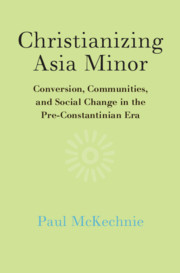Book contents
- Christianizing Asia Minor
- Christianizing Asia Minor
- Copyright page
- Contents
- Figures
- Abbreviations
- Preface
- Introduction
- 1 Phrygia in the New Testament
- 2 Hierapolis (Pamukkale)
- 3 Teachers of Asia: Ignatius, Polycarp, Paul and Thecla
- 4 Montanism Part 1: The Origins of the New Prophecy
- 5 Montanism Part 2: Pepuza and Tymion
- 6 Aberkios of Hierapolis (Koçhisar) and His Gravestone
- 7 Aberkios and the Vita Abercii
- 8 Apollonia (Uluborlu): Curiales and Their Families
- 9 Eumeneia (Işıklı) and the Eumeneian Formula
- 10 Christians for Christians
- 11 The Great Persecution and the Phrygian Fourth Century
- Book part
- Bibliography
- Index
9 - Eumeneia (Işıklı) and the Eumeneian Formula
Published online by Cambridge University Press: 07 August 2019
- Christianizing Asia Minor
- Christianizing Asia Minor
- Copyright page
- Contents
- Figures
- Abbreviations
- Preface
- Introduction
- 1 Phrygia in the New Testament
- 2 Hierapolis (Pamukkale)
- 3 Teachers of Asia: Ignatius, Polycarp, Paul and Thecla
- 4 Montanism Part 1: The Origins of the New Prophecy
- 5 Montanism Part 2: Pepuza and Tymion
- 6 Aberkios of Hierapolis (Koçhisar) and His Gravestone
- 7 Aberkios and the Vita Abercii
- 8 Apollonia (Uluborlu): Curiales and Their Families
- 9 Eumeneia (Işıklı) and the Eumeneian Formula
- 10 Christians for Christians
- 11 The Great Persecution and the Phrygian Fourth Century
- Book part
- Bibliography
- Index
Summary
At Eumeneia (Işıklı) distinctive phrasing was used in the third century on the gravestones of Christians. Even at the time of Decius (249–251), it seems, fear of persecution was not severe enough to deter Christians from making their gravestones identifiable in this way. Like other Phrygian cities, Eumeneia seems to have flown below the radar of official scrutiny – a fact which facilitated change in the sacred canopy. Over a hundred Eumeneian formula gravestones survive, some of them dated. The dated examples were erected between 246 and 274. These dated stones (reproduced in Appendix 2) are discussed. They commemorate a partial cross-section of the Christian community at Eumeneia and Apameia (Dinar). On the imperial estates in the Phrygian–Pisidian borderland to the east of Eumeneia, a series of inscriptions attests a cult-based association (the Tekmoreian Guest-Friends) whose purpose was to demonstrate loyalty to the emperor. These inscriptions, with their lengthy lists of contributors, show that polytheist religion was lively and capable of innovation in the rural districts at the time when the Eumeneian formula was in use not far away in Eumeneia and Apameia.
- Type
- Chapter
- Information
- Christianizing Asia MinorConversion, Communities, and Social Change in the Pre-Constantinian Era, pp. 210 - 231Publisher: Cambridge University PressPrint publication year: 2019



